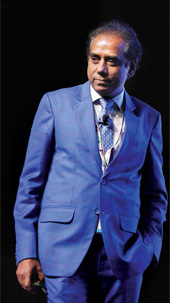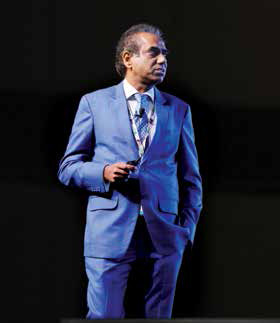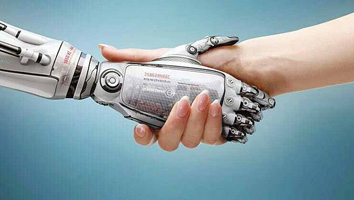As organizations are moving from people- driven to process-driven activity, it has put forth challenges and opportunities for the organizations and the HR professionals to be future ready. At the recently held 21st NHRDN National Conference 2018, at HICC, Hyderabad Capgemini India, CEO, Dr Srinivas Kandula, shared his views on the theme, “Next Wave of Work Excellence”. He highlighted on the transformation needed for ensuring future of work, the leadership required and the role technology will play in the process development and implementation. Corporate Citizen brings the excerpts of his riveting presentation focusing on People, Leadership, Technology and Future of Work

In entire history and mythology of India, there is only one person in Dvapara Yuga, who could foretell what would happen and that is Sanjaya who use to be with Dhritarashtra, the King of Kuru Kingdom of Hastinapur, in Mahabharat epic who would narrate what is going to happen. I am not Dhritarashtra and nor I am Sanjaya. We are in the Kalyuga, where people change jobs, shifting from company to company and sector to sector to reach what destination is quite uncertain. Now here, I am asked to predict what are going to be the waves of future of work excellence let me make a humble effort.
If we want to understand what is going to be the future of work, first we need to understand, being a corporate person, how the economy is moving. I have divided our growth story into three phases, in order to explain my idea. I call till 1990 as the past and from 1991 when we kick-started the liberalization till 2009, as the present, and 2010 onwards the future. We cannot start or stop any phase, because it is a continuum. So, we moved from past agrarian economy to industrial economy and now we are in tech-enabled service economy. And we seem to be moving from socialistic economic policies to very pro-market polices, to very competitive policies. Therefore, we moved from public sector dominance to private sector emergence, to complete corporatization, as we are in today. Even unorganized economic activities are getting completely organized, like retail. So, as the economy is moving, the GDP is also growing rapidly. As all these is happening, therefore the workforce profile is changing.
In the past we used to have majority of people working in agriculture sector now majority of people will be moving to service sector. Probably by 2025 it is estimated that 48 per cent of the workforce will be working in tech-enabled service economy. If the profile of the workforce is changing, it is causing change in the principles of work the basis for any people management and the basis to design any HR policies or practices. The past was riddled with standardization, then we moved to de-standardization and customization. We want to standardize whatever we have produced by way of activities, then we wanted some kind of de-standardization to get out of the monotony, and now we very quickly moved to customization. People want customized automobile, textile, healthcare they want undivided attention. The organized sectors are moving from centralization to decentralization. What we used to think permanent during my younger days like somebody constructs a house they do it for generations or they buy a wristwatch for generations to come. Yes, we moved quickly to the change, where people now want to change everything.
One generation wants job security, other generation wants compensation benefits and third generation wants high career growth their preferences and their motivators are quite different. Therefore, no longer authoritative leadership can work, no longer democratic leadership can work the only leadership that can work is the First Among Equals
There is a book called “Machine that changed the world”, it is about future of the automobile. When you start changing your car, you get an idea why don’t I change my job why don’t I change something. So, now staying at one place or being permanent is seen as very inefficient and unintelligent behavior. Now, we are slowly moving to a large scale transformation. When I started my career as an HR professional, never a single individual came to me to negotiate on salary, benefits or anything. For last 15 years, I have never seen trade union leader approaching me for anything other than individual employees demanding variety of things. So, we quickly moved from collectivism to individualism and now people have started moving to objectivism very quickly. Activities used to be very mechanical and people with mechanical skills would get highly paid that quickly moved to spontaneous skills, like that of cine actors, singers, musicians, writers etc. Then we started moving to something called creative, wherein we want our leaders to behave very different from the normal people unlike the US, where they want their leaders to behave like middleclass people. In India, if you are a middleclass person, you can’t afford to have more than one wife, but if you are a leader, you can have multiple. In the US, if you are a middleclass, you can have as many wives as you can afford, but if you are a leader, you can’t do that.
The way you are defining the work in the past you can simply motivate people by Hygiene Motivators. But, as we quickly moved, they need a combination of hygiene and motivators and now we have quickly moved into exclusively for motivational factors no longer hygiene can motivate the people. The principles of work are changing very quickly from one way to another and if you want to excel in your people management, you need to quickly grasp what are those principles of work, that can impact. Therefore based on this, I hypothesized seven waves that could shape the future of work.
The only thing that is left, where you cannot automate or you find extremely complex to automate, is the social intelligence. Here is the gateway for the HR professionals and here they can make a huge difference

The biggest competition for the human beings is not the workforce that is going to come from other workmen, but from machines. If you visit today a car manufacturing unit, in India, like Volkswagen or Ford, the robots are manufacturing millions of units. Professional service company, KPMG, has done a study, which indicates that our entire IT services industry in India is based on a business model called ‘Labor Arbitrage’. The moment you bring in the machines, the cost efficiency is as high as 30-40 per cent. Therefore the biggest competition we are facing is not from other IT companies, but from automation of service offerings like testing, infrastructure management services, the famous enterprise resource planning etc. In the coming 5-8 years, you will see that coding will completely disappear and you will not require any human workforce over there.
In the UK the number of robots shipped into the country, is getting doubled EU no longer requires visas, emigration, regulations etc. While some people are quite bothered about this kind of regulations, on the other hand what is going to happen is not quite sure, but the machines are completely taking over the work. Now, you may have to redefine or retackle human resource management as human-robot management, may be in the future. So, you need to understand, how you are going to distribute the work between the robots and human. A study has been done in UK on what work could be automated. The sales activity, which is the centrally associated intelligence, also can be automated to a great extent. The reality is there will be more robots than human workforce and as HR professionals we need to figure out the interaction between these two and what will be the chemistry.
2. Defining the human workforce creativityToday creativity is as big a challenge, as illiteracy was in the nineteenth century. We created coaching centers, colleges and schools, who have mastered the art of killing creativity decisively. If you send your child to any of the coaching centers, you will successfully and completely kill the creativity in them. And now if human beings don’t have creativity, what else they will have, when the rest is taken over by machines. There is a study done by McKinsey, wherein the creativity scores are positively correlated with an organization’s performance the growth rates are quite steep and the Ebitda is quite steep compared to those organizations where creativity scores are lower. So, I hypothesize that the second greatest wave that is going to hit in organizations, societies, and governments creativity is the king and whosoever can hold the power of creativity, will rule the world and rest have to follow them. If you look at India today, we are lagging behind in Intellectual Property (IP), while in countries like the US and Japan, there only focus today is building a knowledge economy, building innovation, and they have pushed manufacturing plants, the routine and low end work, to the developing countries.
3. Co-working of multi generationsThe third wave that will shape human resource profession, as well as the work, is that there will be co-working of multi-generations. Given the early entry of the people into the workforce and given the longevity of life, you will find the late exit of workforce and at least five generations working in the same institution. Now these generations come with their own beliefs, their own behavior and assumptions, which can come into conflict. In terms of their basic beliefs, how are you going to forge collaboration and teamwork?
4. First Among Equals leadershipOne generation wants job security, other generation wants compensation benefits and third generation wants high career growth their preferences and their motivators are quite different. Therefore, no longer authoritative leadership can work, no longer democratic leadership can work the only leadership that can work is the First Among Equals. To bring conflicting groups together and to make them very functional and productive, would be possible only through First Among Equals leadership.
Now, you may have to redefine or retackle human resource management as human robot management, may be in the future. So, you need to understand, how you are going to distribute the work between the robots and human

By 2020, around 43 per cent of the workforce in the US, would be freelance employees. They chose when to work, they chose the place to work, they chose who they want to work with. They are no less than a specialized doctor, who consults different hospitals during the day they chose there working days. And given the deficiency of highly skilled people, there is no way but to engage these creative people in multiple organizations. Therefore, HR people need to figure out when people are not members of one particular institution and as there are freelance employees, how are you going to organize the performance management. How are you going to organize them to bring them on to the board and to produce the kind of things you want. It is going to be quite an interesting phenomenon. We are expecting in India by 2030, around 23 per cent of the workforce will be freelancers.
6. Focus on end customer or end usersAnyone paid highly must be carrying out a meaningless job. People getting less paid, must be carrying out a meaningful job and that’s what the data shows. Now people don’t need to barter on salary, to get good quality work done. They are going to focus on how it is going to impact the end customer or end user.
7. Social IntelligenceThe only thing that is left, where you cannot automate or you find extremely complex to automate, is the social intelligence. Here is the gateway for the HR professionals and here they can make a huge difference. The data shows that people with high source of intelligence will get paid five-times more than a good mathematician. And their probability to get jobs is very high. Unfortunately, we so much believed in Stanford-Binet IQ, that we started training people only one quantitative attitude and some linguistic proficiency. And we started giving everybody 90 or 99 per cent there is a huge academic inflation, known as a James Flynn Effect. When I was doing my 10 standard, in a government run school there were 50 of us and hardly 1-2 per cent would get first class rankings and 5-6 people in second class, and half of the class use to fail. Today, I visited the same school and I found that out of 50 students, 40 pass with distinctions. The number of engineering colleges built between Chennai and Bengaluru, I do not know what we will do with them may be later we have to convert them into cyclone shelters or marriage halls. Now the issue is allowing people to build fundamental skills, fundamental curiosity to know something and to observe something, so one can create artificial intelligence for the machines. Don’t give up, create artificial intelligence from the humans.
These are the seven waves that will shape the future of work and this are my ideas of future of work.
By Rajesh Rao